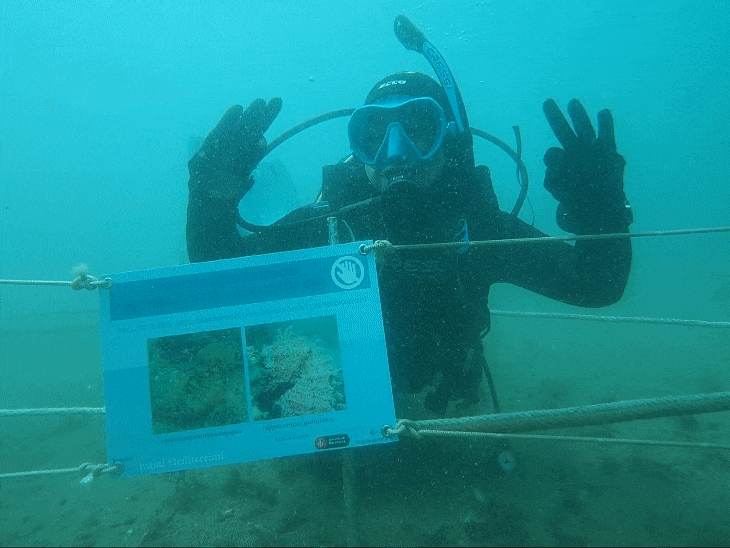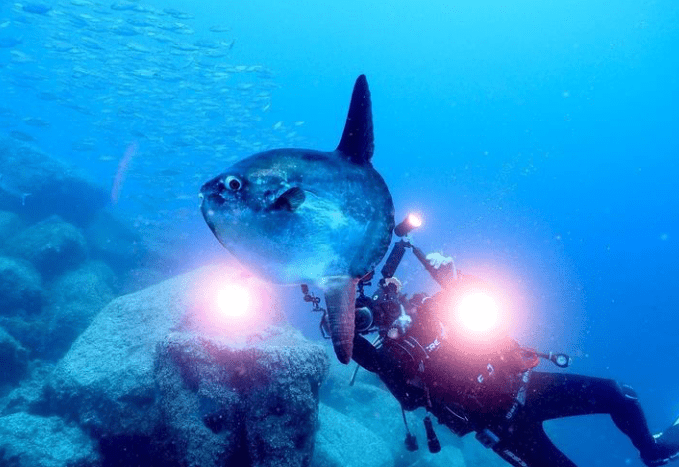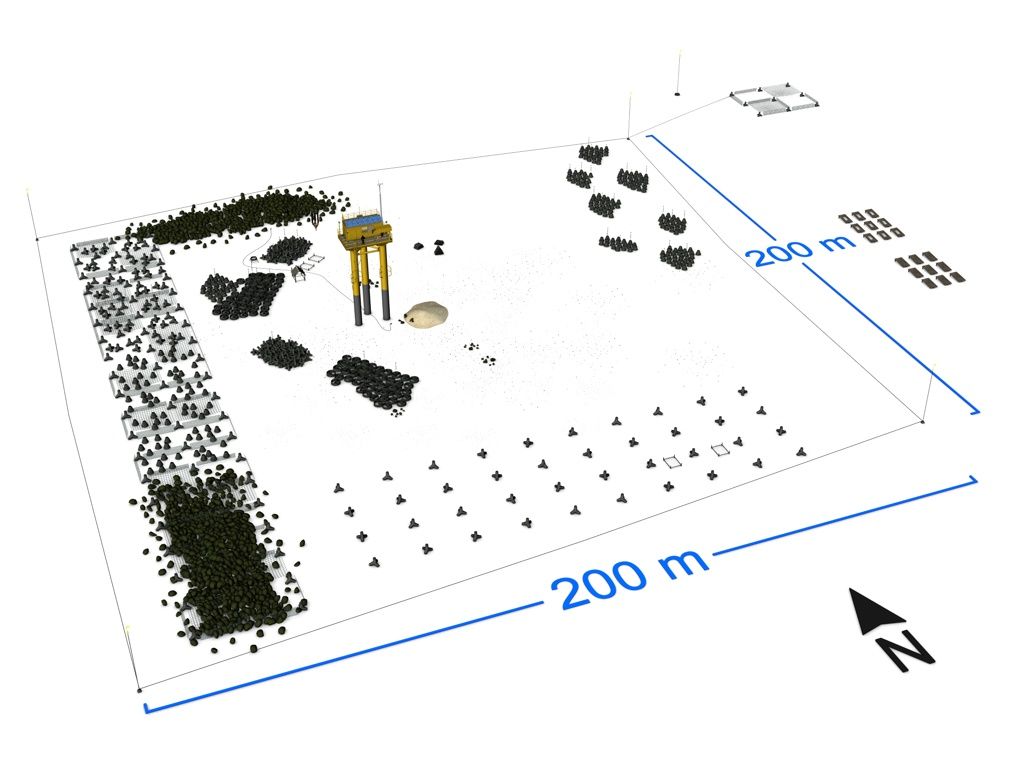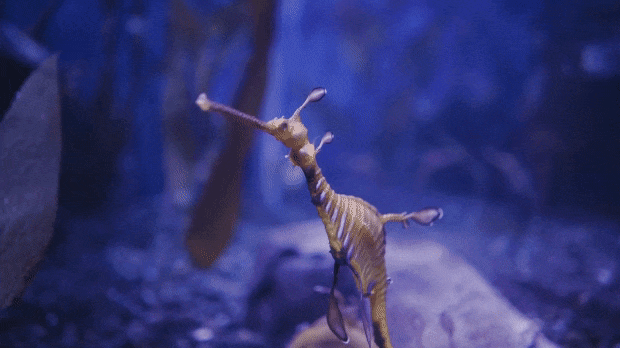
When artificial is beneficial: biotopes that enrich the sea
Is it possible to increase the number of seahorses and sunfish in the sea? Yes, thanks to biotopes, artificial reefs that create favorable habitats for certain species. They are gaining prominence on the coasts of the Mediterranean and other seas of the world and in recent years different projects have been created, some with the support and collaboration of ports.

A biotope in Barcelona
The word biotope comes from the Greek word bios, life, and topos, place. Its definition leaves no room for doubt: these are places where the environmental conditions are the most suitable for life to develop.
"They are structures that, if placed in areas where they are demonstrably needed, help a species to live in good conditions and reproduce," explains Andrea Comaposada, biologist and founder and director of Anel·lides, an organization that promotes research, knowledge and protection of the marine environment.
"Biotopes favor the balance of populations and the regeneration of life in degraded areas, such as urban areas in Barcelona. But this does not mean that they should be installed just anywhere: it is important to carry out biological studies to determine the need to build a biotope and its characteristics," says Comaposada.
"In these biodiversity studies, we look at both the total number of species and the number of individuals, or whether they are juveniles or adults, for example. They must be carried out over a long period of time, to understand the evolution and changes that occur in the ecosystem," she adds.
During the last eight years, Anel-lides has carried out a study of these characteristics that has led to the creation of a biotope on the beach of Sant Sebastià, in the Barceloneta district of Barcelona. It is a pilot project that seeks to create a favorable territory for seahorses. The biotope was installed in May 2024, promoted by Anel.lides in the framework of the RES-MED restoration project, led by the Institute of Marine Sciences (ICM-CSIC).
The structure of this biotope consists of natural ropes and rods, so that the seahorses can attach themselves to the natural fiber ropes with their tails and settle in. "With this pilot test we want to see whether or not it favors the arrival of seahorses to the biotope and increases its population. We have placed ropes of different sizes, to see in which ones they stay attached and adapt better," explains the director of Anel-lides.
"Our goal is to create a habitat for this emblematic species that lives here but is in decline. We have done this after noticing that fewer and fewer observations of seahorses are being made in the area and that the creation of a biotope could be favorable," adds Comaposada.
The Mediterranean's largest artificial underwater reef
About 80 kilometers south of the beaches of Barcelona and the specific biotope for seahorses, is Torredembarra, a town that has in its waters the largest artificial underwater reef in the Mediterranean and the first of its size in the world.
Known as the Torredembarra Biotope, it is shaped like a pyramid, made up of 40,000 tons of calcium carbonate rocks and sits at a depth of 34 meters. It was built in 2023 with the aim of restoring the ecological balance of the area and promoting the natural reintroduction of native species. Its shape and material respond to a need: the seabed of Torredembarra is composed mainly of sand, and the lack of rocks and other natural structures prevents some organisms from living and reproducing there.
Behind the construction of this biotope is the initiative of Miquel Rota, a builder of artificial reefs through Natural Art Reef and owner of the dive center M. Roca Diving, and Oriol Milà, oceanographer and director of the Port of Torredembarra. One year after its construction, this biotope has already left its mark on the area's biodiversity.
"It has an impressive permanent cloud of marine life around it, it has become one of the few known cleaning stations for sunfish, so it is a common sighting, and there have already been several dives with dolphin sightings by divers," say those responsible.

From the Baltic Sea to Australia
In northern Germany, the Baltic waters present a similar problem to those of Torredembarra: in many places the seabed is sandy, providing few refuges and feeding areas for marine species. Other reasons, such as the degradation of their habitats, have caused many species to experience a decline in recent years. To address this problem, a project funded by the European Union has shaped two artificial reefs off the coast of the German towns of Nienhagen and Rosenort.
These reefs are made of natural rocks, concrete structures, mesh fabrics and ropes that act as a base for algae, mussels and many other organisms to grow. "The two reefs provide large-scale artificial underwater habitats that create shelter, feeding and resting areas for the fish species present in the area," the European Commission explains.
In addition, the presence of these biotopes is seen beyond the area they occupy. According to studies conducted in recent years, fish that grow in the biotope (e.g., cod, the species most favored by this artificial reef) end up dispersing over a larger area and thus increasing their populations.
On the other side of the world, in southern Australia, biotopes with similar objectives have also been installed. One example can be found in Port Phillip Bay, where different artificial reefs have been installed to attract fish and mollusks. One of them, pyramidal in shape and measuring four meters wide by five meters high, has as its main objective to provide breeding habitats for pelagic species, thereby increasing marine biodiversity and improving water quality.

Dissemination, awareness and environmental studies
The Mediterranean biotopes of Sant Sebastià beach in Barcelona and Torredembarra have many differences, but also similarities and an important point in common: both seek to convey to the population the importance of respecting our seas and contributing to their restoration.
"You don't do science if you don't then explain it," Comaposada maintains. "It's important to tell citizens why we are doing this. Explain to them that there are seahorses in Barceloneta and that observations of individuals are decreasing. That in Barcelona we have a great biodiversity that is not known, because people see the urban coast as places to enjoy only leisure and tourism. After explaining this to them, they start to see them as living ecosystems, which is what they are.
In order to promote dissemination and awareness, Anel.lides organizes different types of activities and educational days (many linked to the collection of waste that alter the life of ecosystems) in which citizens can participate. In Torredembarra, the biotope is closely linked to scuba diving. Three authorized centers take divers to the pyramid to discover how life grows around its rocks. In addition, the biotope is the basis for numerous environmental studies.
When education leaves its mark, it favors the creation of new initiatives that aim to improve the biodiversity of the sea. Some of them come from the youngest: this year, students at the Institut Escola Joan Ardèvol in Cambrils (Catalonia) created a biotope to improve the habitat of species in the Cavet reserve, also in the Mediterranean.
This biotope was made of biocement, weighs about 2,300 kilograms and is located at a depth of four meters and 200 meters from the coast. The structure joins five other artificial reefs that already existed in the area.

The role of ports
Ports around the world are relevant agents both for promoting the installation of biotopes and for monitoring their evolution and subsequent biodiversity studies. The structure of the Sant Sebastià beach in Barcelona, for example, had permits and technical support from the Port of Barcelona, as well as financial support from the city council. And it can go further.
"Ports are a key element in the maintenance of coastal ecosystems, because they are the entry and exit point for ships," explains Comaposada. "They have the opportunity to contribute by legislating, favoring the creation of specific environmental laws that reduce pollution, and by researching, promoting, for example, biodiversity censuses. To contribute, ports must prioritize the environmental part," concludes the director of Anel-lides.



